
Argyresthia pruniella, the cherry fruit moth or cherry blossom tineid, is a moth from the family Yponomeutidae, the ermine moths.

Argyresthia albistria is a moth of the family Yponomeutidae. It is found in most of Europe.
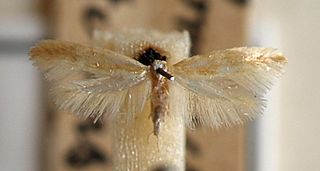
Argyresthia aurulentella is a moth of the family Yponomeutidae. It is found in Northern Europe, Central Europe, western Russia and Macedonia.
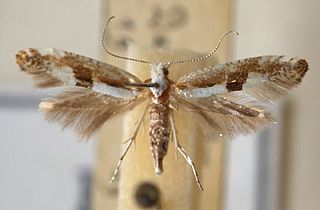
Argyresthia bonnetella is a moth of the family Yponomeutidae. It is found in Europe. The wingspan is 9–11 mm. The head is white. Forewings are shining ochreous-whitish, usually strigulated and sometimes discally suffused with ferruginous brown; a suffused ferruginous -brown median longitudinal streak from base to before middle; a curved dark ferruginous- brown fascia from middle of dorsum to 4/5 of costa, sometimes obsolete except on dorsum. Hindwings are grey. The larva is yellow-green; head and plate of 2 brown.
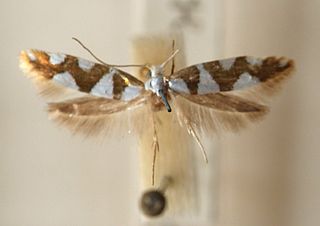
Argyresthia brockeella is a moth of the family Yponomeutidae. It is found in Europe, east Siberia and Japan. The wingspan is 9–12 mm. The head and thorax are white. Forewings are deep coppery-golden; a spot on base of dorsum, a fascia at 1/3, three posterior semioval costal spots and a larger tornal spot shining white; sometimes the fascia is connected with adjacent costal and dorsal spots. Hindwings are grey. The larva is pinkish-brown; head brown; plate of 2 partly blackish-edged.

Argyresthia curvella is a species of ermine moth. It belongs to subfamily Argyresthiinae, which is sometimes elevated to full family rank in the superfamily Yponomeutoidea. It is commonly called apple blossom tineid, reflecting the fact that it was originally believed to be a tineid moth.
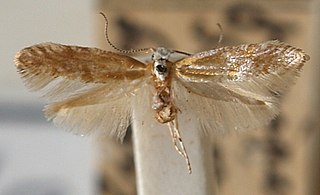
Argyresthia dilectella is a moth of the family Yponomeutidae. It is found in Northern Europe and Central Europe.

Argyresthia spinosella is a moth of the family Yponomeutidae. It is found in Europe and Anatolia.

Argyresthia trifasciata, the juniper ermine moth, is a moth of the family Yponomeutidae. It is found in great parts of Europe, but originates from the Alps.
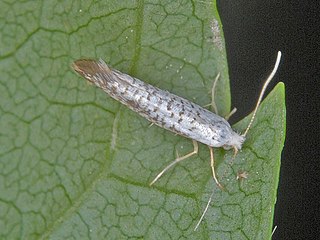
Argyresthia retinella is a species of moth of the family Yponomeutidae.
Argyresthia tatrica is a moth of the family Yponomeutidae. It is found in the Tatra Mountains in Slovakia.
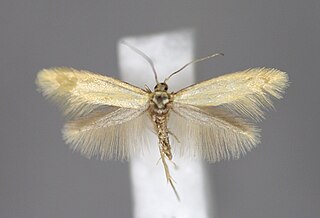
Argyresthia illuminatella is a moth of the family Yponomeutidae. It is found in most Europe, except Ireland, Great Britain, Portugal, Fennoscandia, Hungary, Slovenia and Greece.

Argyresthia thoracella is a moth of the family Yponomeutidae. It is found in the United States including Oklahoma, Arizona, Nevada and eastern California.

Argyresthia oreasella, the cherry shoot borer moth, is a moth of the family Yponomeutidae. It is found in North America, including New York, Michigan, Idaho, Missouri, Colorado, New Mexico, California, Quebec, Alberta and Saskatchewan.

Argyresthia plicipunctella is a species of moth of the family Yponomeutidae. It is found in North America, including California and Oregon.
Argyresthia calliphanes is a moth of the family Yponomeutidae first described by Edward Meyrick in 1913. It is found in Canada from Ontario to British Columbia and possibly in Alberta, Saskatchewan and Manitoba. In the United States, it ranges from New York to California.
Argyresthia franciscella is a moth of the family Yponomeutidae. It is found in North America, including California.
Argyresthia pallidella is a moth of the family Yponomeutidae. It was described by Annette Frances Braun in 1918 and is found in North America, including California.
Argyresthia picea is a moth of the family Yponomeutidae. It is found in Canada, including Alberta, Ontario, Quebec and the Yukon.
Argyresthia trifasciae is a moth of the family Yponomeutidae. It is found in North America, including California.












